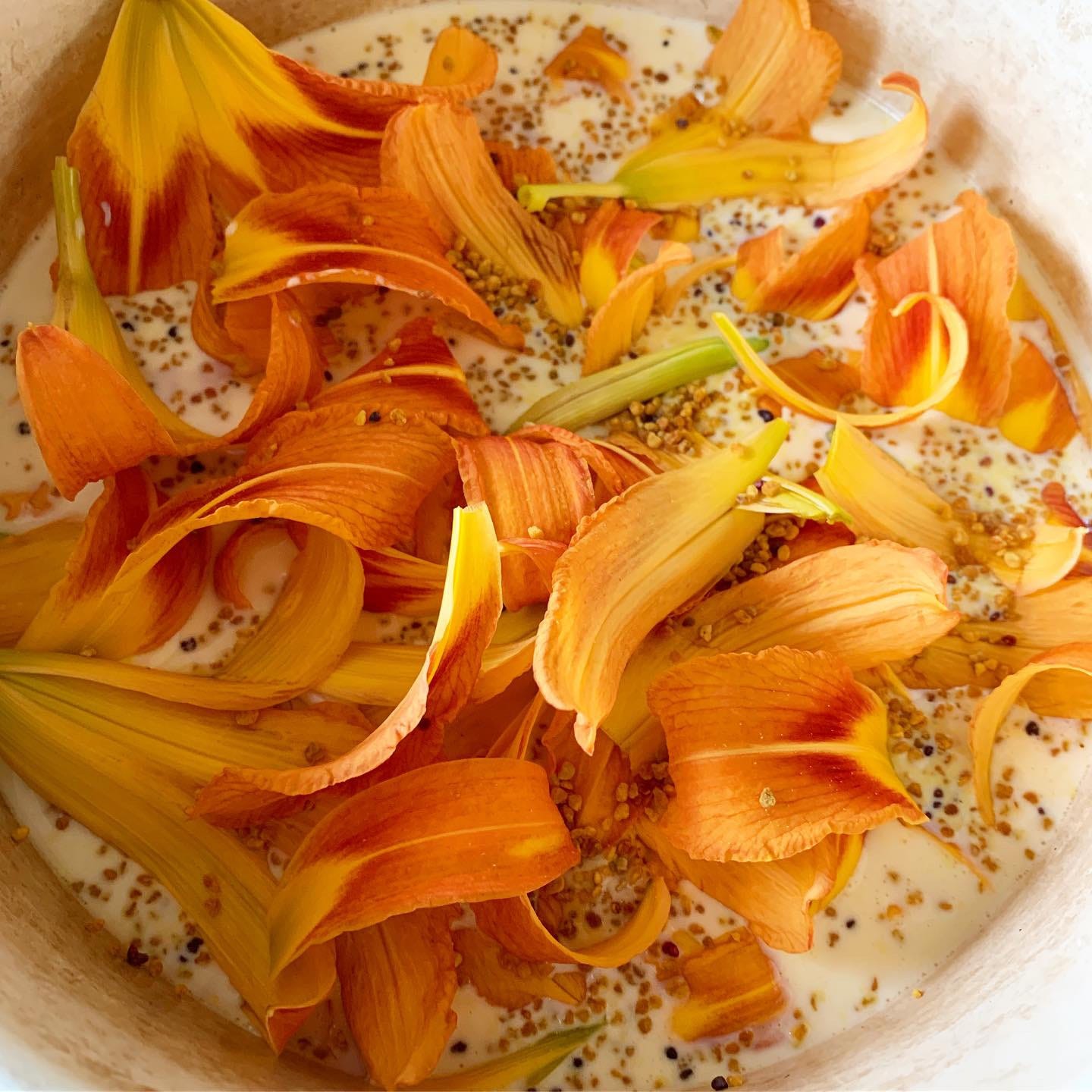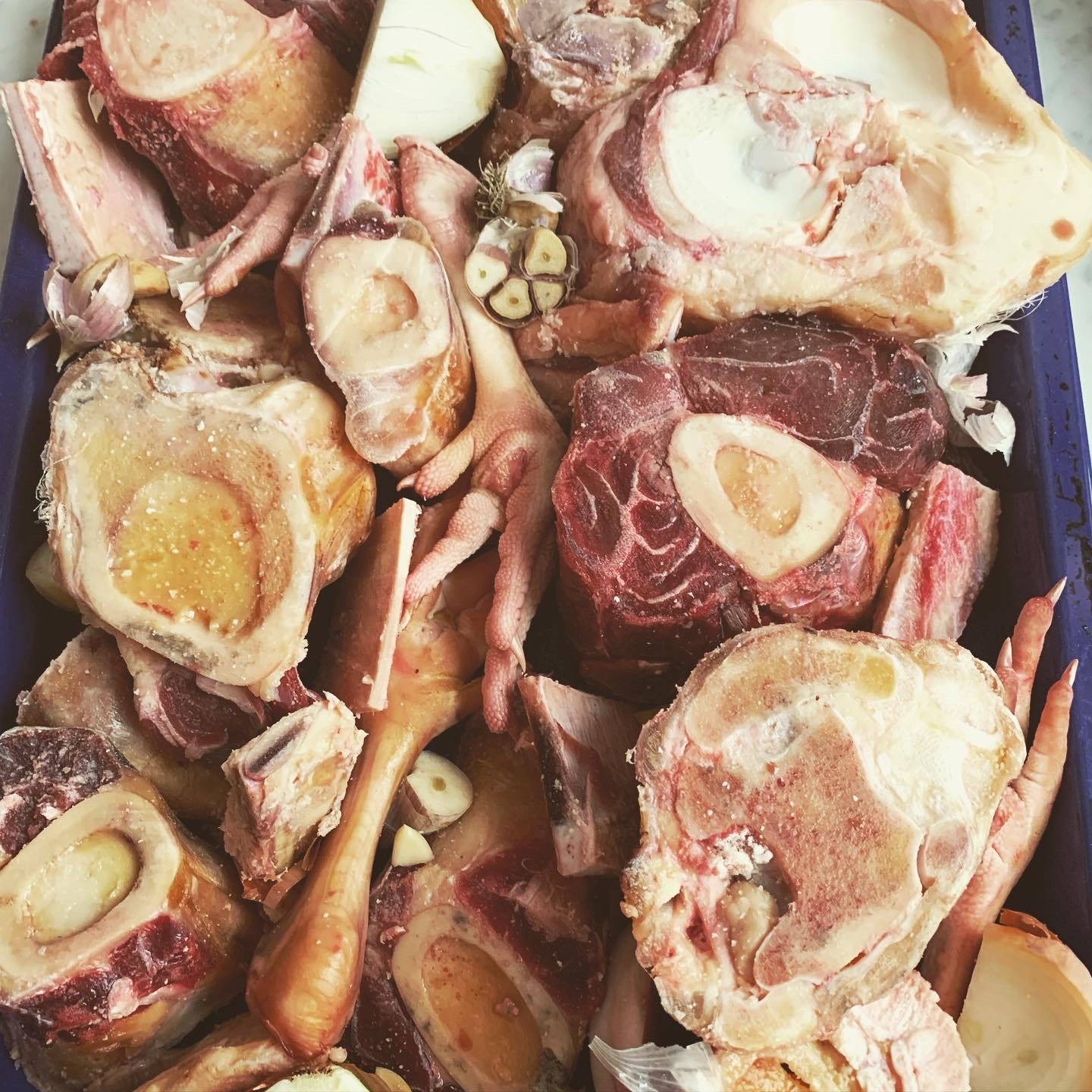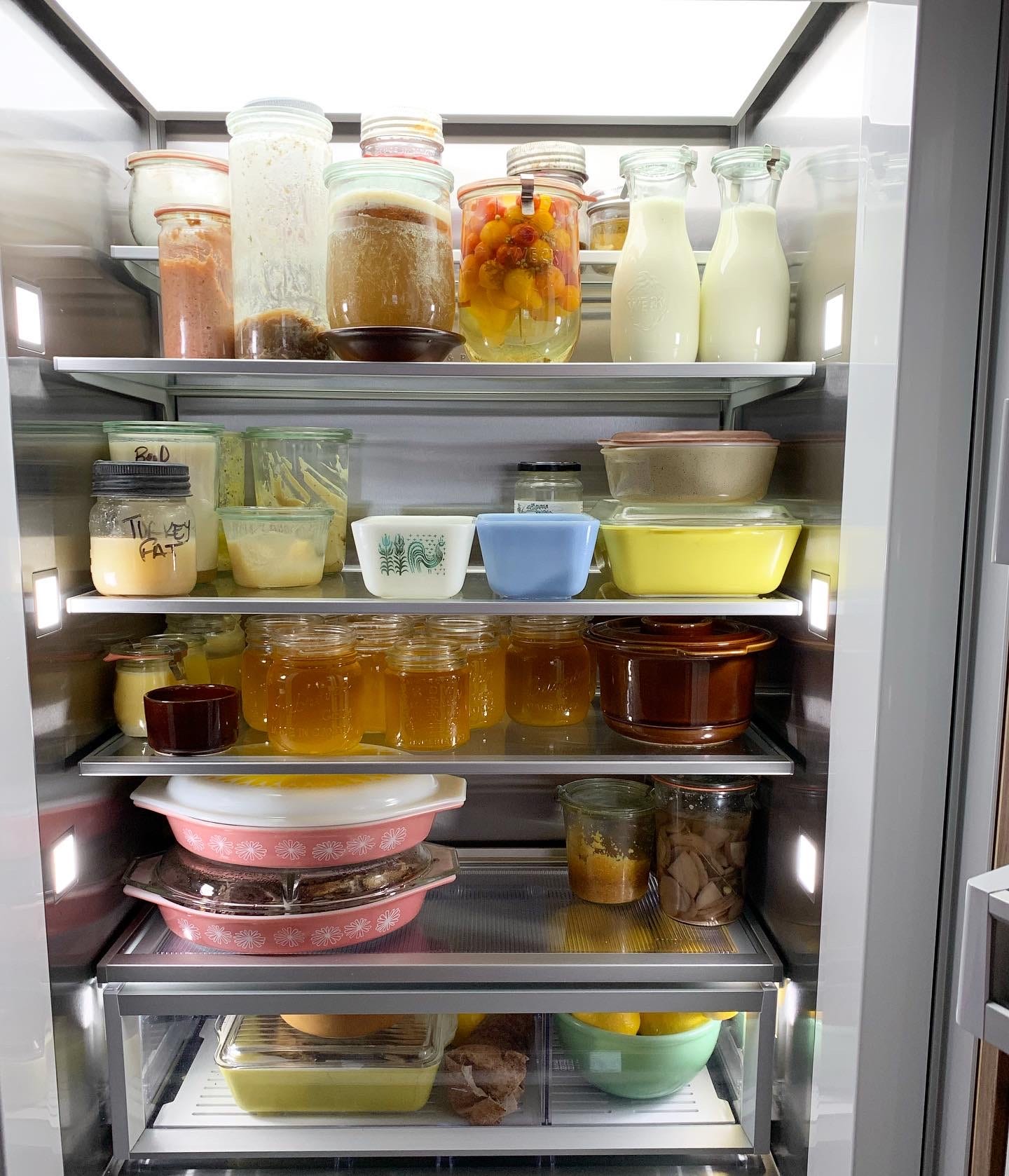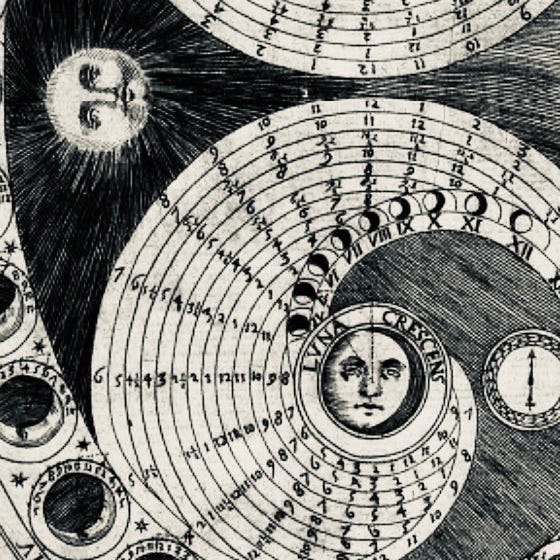One would think a little essay on nutrition should be straight forward: eat real food. The end. Good advice when all we had was real food, or were at least able to decipher it from the facsimiles that were being churned out by corporations that ensured us they had improved on the sustenance of creation. Grey margarine came to the market with colour packs you were to break and mix in before serving so they could emulate the golden yellow of grass fed butter. Local, community grain mills closed when cheap fuel made shipping grains to giant processors a wise economical decision. Then, the processors would ship the grain back, concerns of its delicate fats becoming rancid, no longer an issue. Yeast replaced sourdough. Wild plants were replaced with a handful of the familiar ones we see in the grocery store. Fruit became bigger and sweeter. Animal fats were demonized in favour of the deodorized, toxic vegetable oils that were once reserved for industrial uses. A mass propaganda campaign that rages even still. Our health sold off, one bite at a time.
To say, in our modern environment of ingredients emulating real food, that we should just eat “real food” really says nothing at all. First we have to sift through what actually is real and then sift again. An orange is real, right? Is an orange real? Well, yes it grows on a tree. It’s unprocessed and full of nutrition. But nutrition for whom? Everyone? Does every body recognize that orange as friend or is it foe for some? How was that orange grown? Much fruit today is grown with all manner of synthetic fertilizers, herbicides, and various chemicals. The grower could have opted to have the sewage waste from the nearest city spread on his fields. Sewage waste loaded with pharmaceutical residues, heavy metals, and toxic chemicals from whatever was dumped down the drain. The orange can then be treated to make it last long and look perfect when it arrives at the grocery store. Is an orange an orange then? And when you pick up that fruit, peel it and take a bite, does your body recognize it? What is its message and does it resonate with you?
What even is place when it comes to our food? Traditionally, place was everything. The Inuit ate seal and whale and delighted in the blubber of their catch. The southern dwelling people knew of no such thing. And yet, everyone did well. There’s evidence of what happened some 10,000 years ago when the fertile valley and its people started focusing on grain production - a decline in soil fertility and the health of the people. But we’ve also seen when people stayed true to their environments, receiving sustenance from place, they thrived (and continue to do so for some native tribes).
Today, most of us are orphans from place. In North America, outside of First Nations people, we are all here, cut off from the resonance that our ancestors, all carried, passed down from one another. Each cell, vibrating with the song of place. That’s still in us, but what does it do now? I often think this is part of our problem here. We are animals picked up and plunked down, as if the land and the waters and the skies our people came from and grew from do not matter at all. I think that shows up as a sense of melancholic separation within us and amongst us. All we need do is look around at our society to see it.
With place comes knowledge and connection. With knowledge comes awareness of seasons. Seasons of abundance and seasons of scarcity. Seasons that determine patterns and demands that must be honoured in order to survive. Today, an egg is an egg - available whenever we need it from the grocery store. My eggs aren’t available whenever I want them to be. They are seasonal, as are so many of the foods we eat. When our chicken and turkey hens lay during the spring and summer, we have a glut. In winter, without the fake lighting to drive them into production, we have scarcity. So, too, with milk. In summer, we have fresh milk to make cheeses and butter that preserve that bounty for winter when the cow keeps her energy to warm herself and keep her condition up for the frigid days ahead. Alternatively, we could supplement her with grain, once cheap and abundant, to keep her going. Now, organic grain is not cheap and abundant and soon we will all be seeing the folly of farming systems that have become dependent on these practices as the high costs of animal feed tally up on the cost of food.
So how do we even discuss nutrition in an honest way anymore? Can I give you the “ten things you must do now to be healthier”? Sure, I can, but I also hope to suggest that there’s more to it than that and maybe a framework of how you approach food, and I do mean “you”, is providing a better service than yet another human being telling you what is right and best for your body.
What I can say with confidence is that what is on offer as food today is really a lot of processed ingredients that aren’t really food at all. All we need do is take a look around at our sick, fat, and miserable population to see that buying the claims, and the garbage, that the food conglomerates dole out has done us no good. The real epidemic of our time can be seen all around us. We have bought the advertisement, hook, line, and sinker. Food has become a filler of holes and a friend at the ready. It’s a soother and an entertainer. Abnormal concoctions we could never create in our own kitchens are normalized as food. The doctors don’t ask what you’re eating when you are sick because they’re probably eating the same garbage. The ad campaigns and barrage of propaganda keeps our heads swirling with the intent of having us throw up our hands in despair. If it’s in the grocery store, it’s gotta’ be food, right? With a shrug, we eat and leave it to our bodies to figure out what to do next.
Never mind that we are dulled and depressed and diseased. What does that have to do with food anyway? And if it is food, well… “Just tell me what to eat as long as I don’t have to take out the things I really like, I will probably go along with what you’re saying, but when it’s treat day, I mean… come on we all have to live, right, and it would just be weird to be that person that isn’t partaking and what’s life anyway if you don’t partake and, seriously, you never eat Doritos ever that’s not even possible and if that’s what I have to do well forget it I would rather die than stop eating chocolate and…”
We get to the destination we adjust our sails to. You would rather die than give up____? I always have a little pang of sadness when people say this to me. Really? You would rather die? I guess that’s probably true in bits, both figuratively and literally. I don’t think they believe that they will die if they don’t give up their addiction, but to give it up is a death of sorts to them. Imagine instead, if we could sit with that for a little while and do the real work of excavating our inner motivations. If I would rather die than give up chocolate, what is the physiological driver there? What is it doing for me? What is happening with my biochemistry that runs in parallel to my emotional and spiritual self that sees me so needing of whatever the substance may be that I would rather hang onto it than recognize how it’s hurting the quality of my life today? Affecting who I am today? Why is it okay for me to continue doing something that is hurting me? What is missing and how can I truly fill the holes with sustenance and nourishment rather than the blind stuffing of physical matter, however that looks.
I don’t write this out of an elevated position of righteousness, I write it out of painful experience. In my early twenties, some guru told me to eat a vegetarian diet and food combine, feasting on fruit in our -30 degree celsius winters. I listened. Bladder infections, skin issues, chronic health issues I never had started popping up. My robust frame wasted away to skeletal status. Do it harder, they said. Do it stricter and you will benefit. I was blessed to have found a traditional naturopath from Germany who told me my problem wasn’t a lack of cranberry tea for my bladder infections, but nutrition. He prescribed organic, sourdough bread with real butter and eggs with sausage and warm drinks for breakfast. I thought he was a nut bar, but I listened out of desperation. I am so grateful for him to this day.
But I continued to listen to the gurus, too. I stuck with the whole foods I knew to be healthy because everyone knew them to be healthy. It was obvious. When I reacted poorly to the organic, soured grains, I kept them because they were healthy dammit! When I got achy from nuts, I kept eating them because they were properly soaked and dehydrated and they were organic and lovely and how was I going to make the nutritious snacks and meals and not eat any myself if I kept having to dwindle my foods? When my kids drank their raw milk and grew into robust, vibrant little beings, how could I, too, not benefit? I spent far too long in denial of what I could eat and what just didn’t jive. I did that for all of the aforementioned reasons. I did that because we all do that.
We’re humans at a grand smorgasbord of epic proportions. For those of us that have decided to eat whole foods, to reject the processors poisons, there is still an abnormal offering available to us. We probably feel pretty good, rejecting the toxic food trappings. There’s a sense that we are making the effort to stick with the unprocessed, whole foods that nature has provided, as close to their natural forms as possible. But, really, I don’t know that nature would have ever given us jars and jars of honey or bottles of maple syrup. Would nature have really offered us the volume of nuts we would need to make our almond flour brownies or cookies? Would we have gone out in the middle of winter to harvest our mixed salad greens and avocados. Well, not here we wouldn’t.
There’s the obvious issue of processed un-foods masquerading as edible. And, I think, less and less people able to recognize the distinction between wholesome and toxic. But there are also many foods that have popped up as “healthy alternatives” to the junk that are only a little less worse themselves. It’s a tempting proposition, to eat the delights reminiscent of the ones we grew up knowing and loving, but is it really serving us? And if it is, if we feel fine and really delight in it, well then, who am I to say “don’t do it”? But if they’re not, if they are a crutch that prevents healing and connection, maybe it’s time for a little introspection. Either way, I think it wise to spend some time pondering.
I was a formula fed baby. First cow milk formula, but I had wretched tummy troubles and, so, the paediatrician told my mom to switch me to soy formula. I was vaccinated with the full meal deal, although it was considerably less than what’s given today. Back then, chicken pox and other “diseases” were still left to the purview of the immune system. I grew up with, what I recognize now, as intolerances to pasteurized cow dairy, but I was fully and madly addicted to it. I could throw back a carton of milk in a few minutes. I had chronic tonsillitis and strep throat. I remember days and weeks of suffering with that horrendous affliction, again and again being brought to the paediatrician for another round of antibiotics, desperately waiting for them to kick in so I could swallow again. That lasted into my teens. The number of prescriptions I took that wiped out my non-existent gut bacteria, were countless. In my teens, I developed acne. The doctor wrote me a prescription for tetracycline. I was on it continuously for four years.
Knowing what we know about the need for an infant to be inoculated with the myriad of beneficial bacteria from the birthing canal to the breast, with its rich colostrum, to mother’s milk and so forth, we can make some pretty decent conclusions about how many of us have started our lives hobbled. Can I get that back? Can I ever be that robust, healthy, vibrant little being I had the potential to be had the wisdom of creation been adhered to? I will never know. Just like I will never know what it is to live before a time when electric frequencies penetrate my every cell, artificial lighting overrides my body’s natural rhythms, vaccines infiltrated my immune system, vegetable oils were used as building blocks for my cell membranes, and all other manner of technology invaded what, up until the very near past, was impossible imaginings to any human body.
I can’t know. You can’t know. But what does it mean for me today? It means I have to surrender my desire to be given a roadmap to my body from anyone or anything outside of it. It means that what once stood fast as a reasonable recommendation for all, should be seen as suspect for each. We want to believe that the right combination of things to do, things to avoid, things to add in, delivers a key to the gates of health utopia for us all. But maybe, some of us are bruised, a little busted up from the assaults of our environments and just living, and the real gifts are in a deeper connection to ourselves, by honouring the messages of our unique bodies.
For me, this looks like readjusting to place. I may be built of the blood and memories of Eastern European ancestors, but I am here, in this place. Can I come to know this place so that my children and their children have cells that recognise the bird song, the wild foods, the taste of the soil in the meat they eat from here? Can they be built of the terroir of our home and share that with the echos of their ancestors within their bodies? Can the story continue to unfold? I do believe it can. I do believe that, very much indeed.
If I cannot eat a potato without pain, is it right for me to search up all that makes that potato a devil to me and tell you too, to avoid it? I’m inclined to because I know how much better I feel without that little tuber, but here I live with others who do enjoy that potato with no ill effect. Young women that were once little girls who did receive colostrum and a breast to nurse on. Little girls who didn’t know western medicine, but were healed with deep nutrition and plant medicines. Now young women that can eat potatoes.
It’s the animals that heal me, both in their lives and in their deaths. They walk alongside and connect me to the earth by their example of presence and authenticity. A cow, given grass, her herd, life under the sky, sees no need to ponder the possibilities of tomorrow’s horrors. A bald eagle soaring above knows only the thermal waves under its feathers. Fully inhabited in self.
It is not lost on me, then, that those very lives of the animals in our world, are what my body asks for to heal itself in their deaths. Animal foods, the traditional, highly valued, deeply nutritious foods prized by our ancestors since the dawn of time, are what bring me satiation. When I eat these foods, the cultured raw cheeses, the drippy braised beef roasts, the venison steaks seared in goose fat, the tallow and the lard and the goose eggs and the liver, my body reports back with a hearty affirmation, impossible to ignore. “Wonderful! Bravo! Do it again!”
But there are times, too, when my body’s megaphone is turned so low that I can barely make hide nor hair of it. “What? What was that? You want more cherries/chocolate/cheese? You want some nuts, is that what you’re saying?” Don’t be fooled (or be fooled, but at least know you are). I’ve written of this before, I call it static. The static that muffles the messages of a body that would never betray you. These are the wayward smoke signals of exhaustion, imbalances, food addictions, etc.. that bubble up, mimicking the sounds of a body that only, truly, wants to be nourished. We must come to understand the difference. Remove the static and you will hear what your body is actually telling you.
Part two will be released this Saturday and will be an audio addendum with a little peek into what we’re eating now, in this season of our lives. I’m going to see if I can get Troy to hop on the microphone with me to talk just a bit about how he approaches his nutrition during the different phases of his physical fitness/training year. We’ll see… he gets a little shy when I pull out the microphone. Even the mere suggestion of it had him mumbling something about “I’m the background guy” and scuttling away.














Oh boy! You are so speaking to my choir with this essay. And I needed it—as I slipped into eating corn chips in the past weeks. Static. I love that. Time to figure out the why of the corn chips—and of course there is plenty of “why” today in the USA about which to worry. In any case, know that for years each of my emails has a signature block that has my name and “Occupy Your Kitchen” beneath it! But thanks so much for this essay.
Beautifully written and thoughtfully provoking. I also was a formula fed baby, with lots of sugary, processed foods through childhood and into my teen years, although my mother would feed us the cultural foods of our her homeland. Lengua (beef tongue), guatita (tripe stew) and various animals stews were frequent meals growing up.
Despite having allergies and constant infections of various kinds, and given antibiotics, I think eating these nutrient dense meals helped save me from developing more severe illnesses.
When I hit my late teens, I discovered nutrition played a huge role in how I felt. And so began my life long journey into finding the perfect 'diet' or foods for optimal health and wellbeing. Now, in my late forties, I have settled on eating a mostly animal based diet, as this is what makes me feel my best.
Love your blog, it reminds me to stay true to my beliefs and ideals...and oh, btw, that braunschweiger looks so delicious! Is that home made. (stupid question, I know)? I've tried too make it, but the recipes I've used weren't the greatest. Care to share the recipe or point me to where I can find a really good one to begin again?